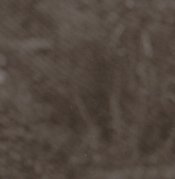I use soot straight out of my chimney for pigment. I use 3 grams of soot in 100ml of 10% gelatine. I put the soot in a mortar and give it a grind to break down the lumps, then add a few drops of gum Arabic and grind it well to a thick paste for about 5 minutes. I then add my hot gelatine a little at a time to the mortar, mixing it in well until all of the gelatine is in. I then filter it once through a double layer of old stockings. I do get small 'gritty' specks in the final print, but I like the effect as it seems a part of using home-gathered pigments.
The downside of using soot is that the kitchen smells of soot for a fair few hours as the tissue dries out!
Best regards,
Evan
EDIT: once the tissue dries out, it is just like the posted image of a bumpy surface, some of my tissues have been extremely rough. When I spirit sensitise, the gelatine swells back up and the bumps disappear, allowing a decent contact between the tissue and the negative. I normally also use an old comb for spreading out the glop onto the backing paper. If I did a bad job at grinding the soot in the mortar, the pattern that the comb teeth made can be still visible on the surface after drying the tissue. For these tissues, I do not try to print deeply to get a relief as I get a pattern of gritty/not gritty swirls in the final image.











